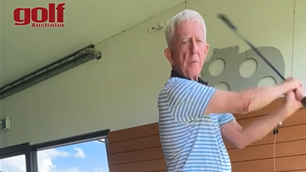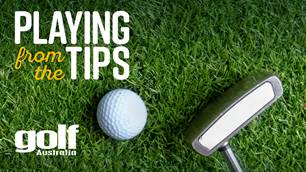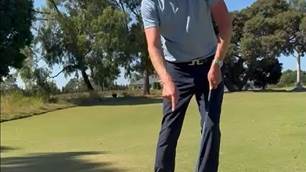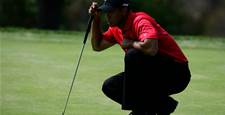Motion capture technology is helping Justin Rose change the spec of his clubs – and his shot shapes.
Motion capture technology is helping Justin Rose change the spec of his clubs – and his shot shapes.
A TaylorMade staff player, Justin Rose is quick to make use of the company’s Motion Analysis Technology (MAT-T) whenever he can to tune up his club set-up. But he admits that what he really loves about the system is its ability to hone his technique. “It bridges the gap between feel and real,” he says. “MAT-T tells you how much you need to exaggerate certain moves you are working on. It quantifies your game, and that accelerates the learning process. Shot shaping is a great example of this. Sometimes you feel you are swinging in-to-out, but this software shows you that, actually, you are not. Here, I am going to show you my approach to draws and fades, and how the system helps me achieve accuracy with both.”
Understanding The Draw and Fade
Not so long ago, when we wanted to learn to shape the ball, we were told “the path sends it, the face bends it”. In other words, the swing path through impact would set the ball’s initial direction, while the position of the face at impact would apply the spin.
However, thanks to launch monitor technology like TrackMan, we now know this is not quite right. TrackMan has demonstrated that, in fact, the aim of the clubface at impact dictates 85 percent of the club’s starting line. If my face is well open, the ball is going to start to the right, irrespective of the swing path. It turns out that the face pretty much sends it and bends it.
To understand what this means for shot shaping, we must first make sure we understand the draw and a fade.
Let us take the draw. For the right-hander, the idea is for the ball to curve left through the air, in towards the target. This of course means the ball must first be sent right of that target. As we now know, the face is the major contributing factor in setting that line. This means, somewhat paradoxically, that to hit a draw, the face needs to be open to the target at impact.
Equally strangely, the face should be closed to the target at impact to hit a fade, which requires the ball to start left. Things start to make a little more sense when you consider the swing path. For that “open” clubface to apply drawspin, it must be closed to the path the face is moving along through impact. So to hit a true draw, the face at impact must be open to the target, but closed to the path. Of course the opposite is the case for a fade – the face is closed to the target but open to the path.
I sense I’ve confused you enough, so let’s see how this works in practice, with a little help from the MAT-T system.
THE DRAW
Set up
As I mentioned, all the work for shaping shots is done at address. I am careful to follow a process that allows me to set up the right relationships with my lines:
1. I line up the clubface accurately. With the draw, that means aiming it a little right of target. The tee pegs either side of the ball illustrate the face’s aim. The bigger the draw, the more open to the target the face will be.
2. Now I set the aim of my feet, hips and shoulders, to program the swing path. I don’t get super-specific with my feet; I simply know that if the clubface aims right, the feet must be further right. This is where feel comes in. You can’t go ‘face five yards right, feet 15 yards right’. That’s not how we play golf. The shaft by my feet represents the body’s aim. As you can see, it is further right than where the tee pegs are pointing.
So I have now set up a situation where the face is open to the target but closed to the path – perfect for a draw.
At The Top
I said earlier that you do not have to manipulate the swing itself to hit a draw or a fade – and here’s the proof. I’ve simply made my regular backswing, trusting in the relationships I set at address to do all the work. The “across-the-line” look of the shaft at the top is simply a consequence of aiming right – and it’s good to see the shaft pretty parallel to the one on the floor, representing my toe line.
Through The Ball
The common perception of the draw is of releasing the hands and arms through the ball, rotating the forearms to close the face and so create the draw spin. But with the face being so influential on the ball’s initial path, this is why so many people that try this start the ball too straight, and end up left. Don’t forget, you need the face open to the target at impact to send the ball right.
I am actually very passive through the ball. I’m not trying to manufacture anything with my hands; I’m just trusting the fact that I’ve set everything at address. If I swing in the direction of my feet, I know I’m going to create a right-to-left ball flight. If I do have a swing thought, it is simply to keep my hands ahead of the club through impact. Hands ahead means the face is open.
THE FADE
Set Up
As with the draw, the shot shape – the ball starts a little left of the target before feathering back to the right – is created simply through my address lines. The process for setting them up remains the same:
1. Aim the clubface first. The ball must start its journey left of the target, so that means aiming the face a little left of the target. Again, I’ve used tee pegs to show the face aim. It may feel odd to you to see the clubface closed to the target for a shot you need to cut – but persevere, and remember the fadespin is created by the face being open to the swing path at impact.
2. Once again, the alignment of feet, hips and shoulders dictates the swing path. The important thing now is to create a foot line that is further left than the clubface’s aim, because the face must be open to the path if the ball is to fade. The shaft on the ground, representing body aim, shows I have achieved that.
At The Top
I really don’t give much thought to my backswing when shaping the ball. As long as I don’t try to manipulate anything, the club will move back through the path and arc set by the body’s alignment. Again, it’s good for me to see the clubshaft at the top echoing the line of the one on the ground, illustrating my foot line. It shows me I am in good shape to swing through along that toe line, left of the target.
Through The Ball
I have a very neutral golf swing; my natural shot is very straight. Having said that, if I had to hit a fairway I would probably go for a fade because it’s easier for a right-handed person to swing hard left.
As with the draw, my feeling is of being passive through impact; there is no feeling of “holding the club off” or anything like that, because I need the face to aim left at impact to send the ball left.
My only thought is taking the hands out and rotating through the shot to let the club swing down the line of my feet.
Related Articles

Video Lesson: Hear the swoosh past the ball

Playing From The Tips Ep.106: Texas Open, LIV Miami & LPGA Match Play












